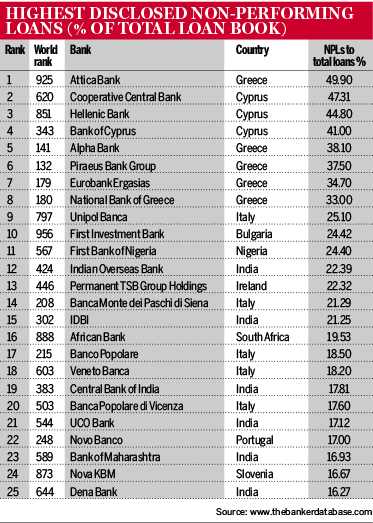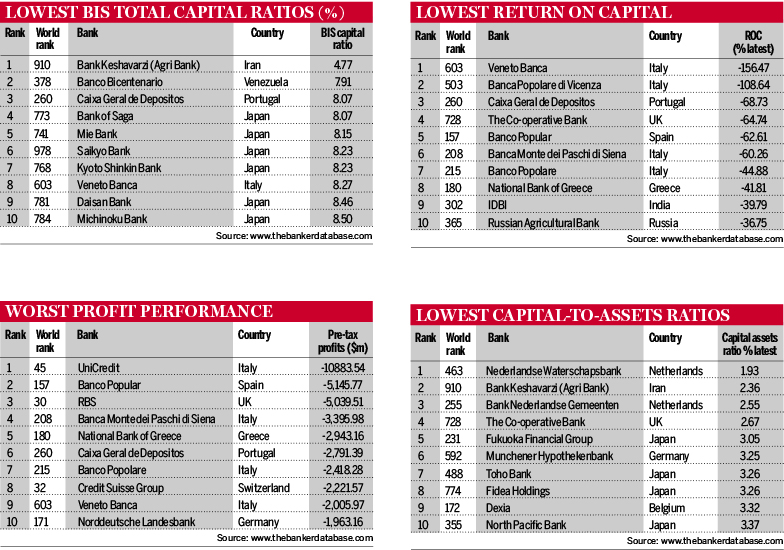Bad loans continue to dog European lenders in this year’s Top 1000 World Banks ranking, justifying EU supervisors’ attempts to force a clean-up of the region’s balance sheets. While some of western Europe’s worst offenders in terms of non-performing loans (NPLs) have improved since 2016’s rankings, the region’s dominance of NPL league tables persists.
Greek and Cypriot names continue to feature prominently among the banks with the most acute NPL problems. Once again, together they account for the top eight spots for highest NPL ratios – however, the ratios have improved.
In last year’s rankings, at least 50% of the three worst performers’ loan books were classified as non-performing, whereas this year the highest ratio is 49.9%, posted by Greece’s Attica Bank, followed by Cyprus's Cooperative Central Bank with 47.31%. While still very high, this is a big improvement on the previous year, when the Cypriot bank topped the table with an NPL ratio of 59.07%.
Italy also features prominently, accounting for five of the top 25 banks with the highest NPL ratios – up from three banks in last year’s ranking.
Outside of Europe, India stands out for having a growing number of banks with high NPLs – with six names in the bottom 25, compared with just two in the 2016 ranking. The Indian authorities are attempting to get on top of the problem. Besides forcing banks to recognise and increase provisioning for impaired assets, the country's new insolvency and bankruptcy code should force faster resolution of bad loans.
In the short term, however, it could actually increase bankruptcies of borrowers, which would have a negative impact on banks, forcing them to increase provisions that in turn erode their profits.
Nonetheless, India’s banks have avoided the dubious recognition of being included in the list of biggest loss-makers. Worryingly, the size of losses notched up by the world’s 10 least profitable institutions soared in 2016. Italy’s UniCredit posted a $10.88bn pre-tax loss as it wrote down much of its loan book, however earlier this year it undertook a €13bn capital raise, which makes it systemically much more stable.
Spain’s Banco Popular lost $5.15bn and was pushed into the arms of larger national rival Santander, while RBS’s $5.04bn loss is more than three times its 2015 loss. Despite this, the UK bank appears to be on the mend, with Moody’s Investors Services recently giving it an investment grade rating.
A notable omission from this year’s list of worst profit performances is Deutsche Bank. In the 2015 rankings Germany’s national champion nursed the biggest loss of $6.63bn. Yet its performance in this year’s rankings, coupled with an €8bn capital raise in February, appear to allay any fears about its solvency. National Bank of Greece and Piraeus Bank Group, ranked second and third in last year’s list, have similarly redeemed themselves by falling out of the top 10.
Japanese banks have increased their showing in the lowest capital adequacy ranking. What is worse, their weakest performers recorded lower Bank for International Settlement (BIS) capital ratios in 2016 than 2015.
Iran, conversely, has experienced mixed fortunes. In last year’s rankings it had the world’s three lowest BIS capital ratios, spanning from 4.94% to 7.07%. This year Bank Keshavarzi (Agri Bank) tops the leaderboard once again, and its ratio has deteriorated to 4.77%. But Bank Tejarat and Parsian Bank have disappeared from the bottom 10.
This year’s second lowest BIS ratio belongs to Venezuela’s Banco Bicentenario, no doubt reflecting the Latin American country’s crisis-ridden economy. And a notable new arrival in the table of lowest capital-to-assets ratios is the Co-operative Bank. The British lender has put itself up for sale after posting a $589m pre-tax lost and nearly halving its Tier 1 capital cushion in 2016.






